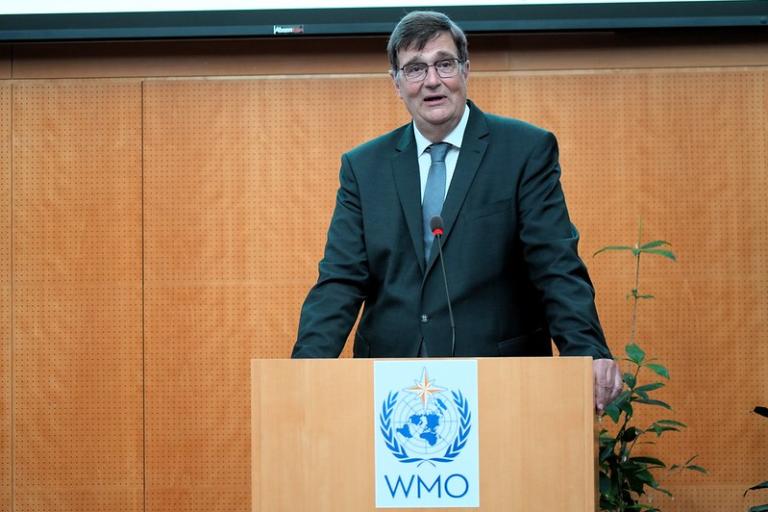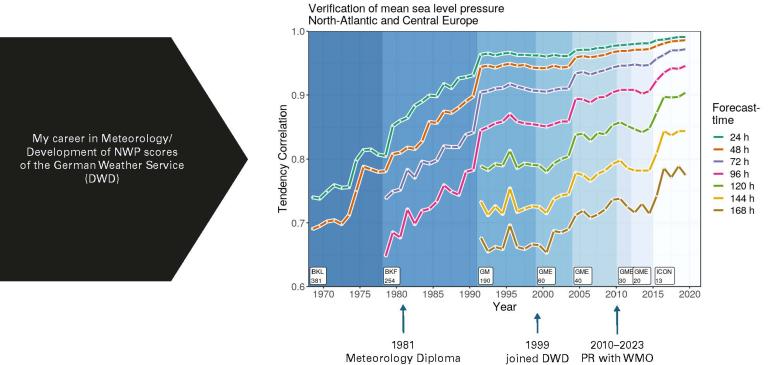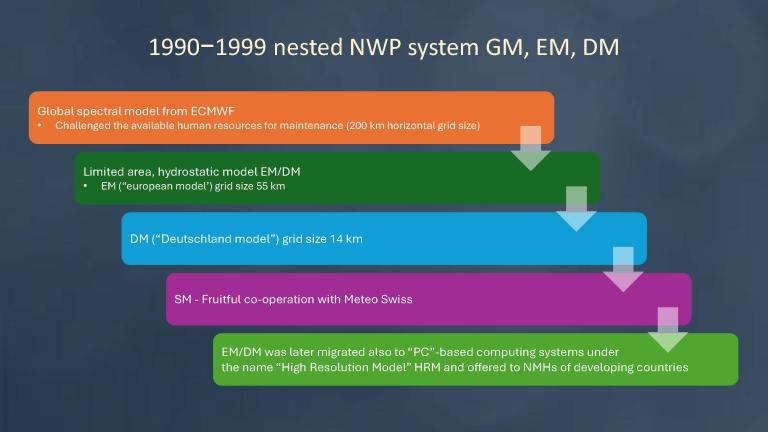An interview with Gerhard Adrian, Winner of the 2025 IMO Prize
- Author(s):
- By Sylvie Castonguay, WMO Secretariat

Gerhard Adrian, who served as the President of WMO from 2019 to 2023 and as President of the Deutscher Wetterdienst (DWD), the German Weather Service) from 2010 until his retirement in 2023, was awarded the IMO Prize at the seventy-ninth session of the WMO Executive Council in June. His IMO Prize Lecture provided an overview of the evolution of Numerical Weather Predictions (NWP) over his 50-year career in meteorology. In this interview, he highlights the main points of his lectures and offers a glimpse at the service improvements that Machine Learning (ML), which is often referred to as Artificial Intelligence (AI), and other technologies could deliver.
WMO Bulletin: Professor Adrian, the image below from your IMO Lectures demonstrates the impressive development of NWP. How did it all start?
Prof. Adrian: NWP started around 1922 with Lewis Fry Richardson, long before my time. He published a book entitle “Weather Prediction by Numerical Process”, in which he documented comprehensively a numerical weather forecasting model. Together with his wife, he tried to calculate one time step in the future. Many years, later Richardson’s model was implemented on a computer that demonstrated that his model could be used for weather forecasting. However, even earlier, in 1904, Vilhelm Bjerknes had published a paper on the basic concept of weather forecasting stating that weather forecasting is a problem of physics and described the two requirements to solve the problem: 1) a coordinated observing system and 2) a sufficiently accurate understanding of Earth’s physical laws to predict a future state of the atmosphere from a previous one. That remains true, NWP can always be made more accurate by improving those two factors.
By the time I began my university studies, DWD was operating a hemispheric barotrope model with a grid size of 381 km. The model did not contain thermodynamic processes such as precipitation or topography. It had only one layer at 500 hectopascals (hPa), where atmospheric behaviour is nearly barotropic. The only physical feature of the model was the conservation of momentum – or the vertical component of the angular momentum, which we call vorticity. The model domain was a hexagon in a polar-stereographic coordinate system with the north pole in the middle of the domain.
At the time, computer technology was at the brink of breakthroughs that would exponentially increase power and capacity, and it would take NWP with it. My IMO Prize presentation focused on the evolution of NWP in my home organization (DWD) after eight European member states launched European Centre for Medium Range Weather Forecasting (ECMWF) in 1975 to answer the scientific question: Are weather forecasts beyond day 2 possible? It took ECMWF very little time to prove that is. Nevertheless, ECMWF is still with us today and it is continuously improving forecasts and their applications.

WMO Bulletin: Today’s 10-day forecast is good as the 2-day forecast was back then and the grid size is now 2 km. What were the important steps along the way?
Prof. Adrian: Basically, there are three ongoing developments to improve weather forecasts for all relevant scales.
- The completeness in the description of the relevant physical processes in the atmosphere:
The first NWP model of DWD had only one layer, meaning that the weather system was assumed to be two dimensional, which is, of course, a very poor assumption. But a three-dimensional approximation was impossible to implement on the high-performance computers available at that time. Today, NWP systems consist of more than 100 layers and horizontal grid sizes less than 2 km. The accuracy of the numerical approximation of the basic physical equation increases with the spatial resolution. Experience has demonstrated that the use of higher spatial resolutions will improve the quality of forecasts. And we don’t know whether there is a limit. Hence, the resolution, or the degrees of freedom, of the forecasting system is limited by the power and capacity of the available computer systems. An increase in resolution by a factor of two in all three directions requires at least a tenfold increase in computer performance. This describes only the perspective of fluid dynamics of the atmosphere. In recent years, efforts have also been made to improve other physical processes in the atmosphere, like the interaction between atmosphere and the Earth’s surface, including the ocean, clouds and precipitation, radiation, effects of aerosols and more.
- Improving of the global observing system and data exchange:
As Vilhelm Bjerkness stated, observations are required to define the initial state of the atmosphere. Over the last 50 years, space-based and surfacebased remote sensing, along with a growing in situ observation network, have been providing more information on the three-dimensional state of the atmosphere.
- Assimilation of observations (data assimilation):
A very important step for improving the numerical weather forecasts was the development of the statistical data assimilation systems. These combine very different kind of observations – in situ: temperature, humidity, pressure, remote sensing from space, and surface-based: backscattered radiation from active radar and lidar systems, thermally emitted radiation observed with radiometers and spectrometers – to provide a best estimation of the current state of the atmosphere to initiate forecasts. It is only this type of data assimilation system that can exploit comprehensively information from different observing systems.

WMO Bulletin: What was the importance of partnership and collaboration?
Prof. Adrian: I concentrated my presentation on the development of the dynamical core of NWP-models in DWD, an important, but not the only, component of an operational NWP-system. The formulations of the basic equations and of the description of other relevant processes in the atmosphere are mostly meteorological problems. The necessary numerical approximations are mathematical problems. The translation into software is becoming more complex and requires IT-specialists. The necessary management of input and output data is a big challenge and requires different IT expertise. My experience is that only some of these very different competences are available in one organization.
Therefore, partnerships and collaboration are essential. The question becomes, where to find these competences and how to convince possible partners to collaborate. It is obvious to look to institutions that are experiencing similar challenges, mostly other National Meteorological and Hydrological Services (NMHS) and their local, regional and international partners.
WMO Region VI (Europe) has established collaborative networks both with intergovernmental frameworks, like ECMWF and EUMETSAT, and non-governmental networks, like EUMETNET. The progress in NWP development achieved by DWD was only possible through collaboration between competent partners who share competences and resources to achieve common goals. DWD, for example, is member of COSMO (COnsortium for Small scale MOdelling), which brings together the NMHSs of Germany, Greece, Israel, Italy, Poland, Romania and Switzerland with their national partners.
WMO Bulletin: What role did WMO play?
Prof. Adrian: From the perspective of physics, weather forecasting (and climate prediction) is a global physical problem, the resolution of which requires global infrastructure for observation of the atmosphere – and the whole climate system – and a global exchange of data in near real time. This global infrastructure, provided by all WMO Members, has been coordinated by WMO for the last 75 years. In 2021, the Extraordinary session of the World Meteorological Congress took important decisions to further improve this cooperation between WMO Members:
- Resolution 1 on the “WMO Policy for the International Exchange of Earth system Data”
- Resolution 2 on the requirements of the “Global Basic Observing System (GBON)”
- Resolution 3 on a “Systematic Observation Financing Facility (SOFF)”.
By using the term “Earth system”, Congress removed the traditional distinction between weather and climate, adopting a holistic approach. The distinction between weather and climate had been helpful in the past to reduce the complexity of weather forecasting, when the task was limited to the short range at the beginning of its development, and of climatology which in turn offered a longrange perspective by concentrating on statistical descriptions of the state of the atmosphere. But it is no longer relevant.
WMO Bulletin: What role did you play in this change to an Earth system approach?
Prof. Adrian: I was a member of the WMO Executive Council (EC) working on a governance reform proposal and its implementation when the discussion began. The reform would revise of the main working structures of WMO, its Technical Commissions, rattling the very foundation of the Organization.
Recognizing that the sector specific approach of the past did not fit current requirements, a new more efficient and effective approach was proposed that would eliminate the eight existing Technical Commissions replacing them with the Commission for Observation, Infrastructure and Information Systems (INFCOM), the Commission for Weather, Climate, Hydrological, Marine and related Environmental Services and Applications (SERCOM) and the Research Board. This new approach was very controversially discussed in all WMO governance bodies as well as in the Secretariat, but eventually Congress approved it.
Here, I seize the opportunity to thank the Presidents of the two Technical Commissions (TCs), Michel Jean (INFCOM) and Ian Lisk (SERCOM), who integrated the work and traditions of the previous Commissions into the new working structures without losing any of the competences provided Members.
The governance reform’s holistic approach implemented a common concept for services and infrastructure that was consistent to the Earth system approach of Resolutions 1 to 3 of the 2021 Extraordinary Congress. In my role as President of WMO, it was a challenge for me to manage the governance reform under all the travel restrictions during the COVID-19 pandemic. Everybody engaged in the governance reform as members of working groups, task teams, EC or Congress were affected. It was particularly difficult to establish the substructures of the TCs under new rules, which meant re-organizing the work of hundreds of experts from WMO Members. We all had to learn to work with video conference software systems, which initially offered poor support for the multilanguage environment of United Nations meetings. We had to amend our rules of procedure, including voting. However, together, we managed the restrictions. EC and the new TCs fulfilled their duties, including the preparation of an extraordinary and an ordinary session of the World Meteorological Congress. Many thanks to all, including the Secretariat.
WMO Bulletin: What new demand is there today for better weather forecasting and climate prediction? And what is the potential to further improve both in the future?
Prof. Adrian: Above and in my IMO Prize Lecture, I described developments to improve weather forecasting from a meteorologist’s perspective. The users’ perspective is typically different. Users are mostly interested in the impact of the predicted weather or climate on their life or area of responsibility. To predict the impacts that a certain weather event will have on, for example, infrastructure causing it to fail, is much more than weather forecasting and can only be done identifying partners with the necessary competence, which are not available in NMHSs.
My personal observation, as a former director of a national meteorological service, is that there is a strong demand for better cooperation with experts in other sectors to improve user services. For example, DWD was asked to provide highly accurate, highresolution temporal and spatial information about wind fields for use in management systems for the production and distribution of electric energy from wind turbines. However, a forecast error of 10% in wind speed causes an error of 30% in the flux of kinetic energy. The factor of three between the forecast errors of wind speed and energy flux is a feature of physics and cannot be changed. Another application of weather forecasting for the same sector is the prediction of Saharan dust, which can reduce solar radiation up to 20% in a very short time. Infrastructure managers often operate their systems at their capacity limits and are thus increasingly sensitive to weather and demanding precise and timely weather forecasts. AI will certainly play a role in the integration of weather forecasts into the management of infrastructure systems as well as the energy sector.
WMO Bulletin: What counsel would you give to meteorology students in university who are today in the same position you were in 50 years ago?
Prof. Adrian: The meteorology, as a profession, has been changing over the last 50 years. When I studied meteorology, my expectation was to work somewhere as forecaster either in a national service or in the up-and-coming private sector, which I never did. Today weather forecasting is a mostly automatic process supervised by a few experts. Many meteorologists work as consultants in NMHSs, the private sector and research organizations. This is probably because improvements in meteorological information have increased the complexity of proper usage thus there is a greater demand for professional meteorological consultation. Ensemble prediction systems have now been available for more than 30 years, but I am not convinced that these systems are being used properly everywhere.
To summarize, my counsel to meteorology students is to grasp at a good theoretical basis, including statistical mathematics, AI and physics, to be able to work in research, the development of applications of meteorological information and to follow developments in relevant scientific sectors. This is nothing new. I don’t like to distinguish between meteorology and climatology, so the same advice applies. A water manager needs to know what will happen in the atmosphere in the next minutes but also what will change during the next 100 years.


